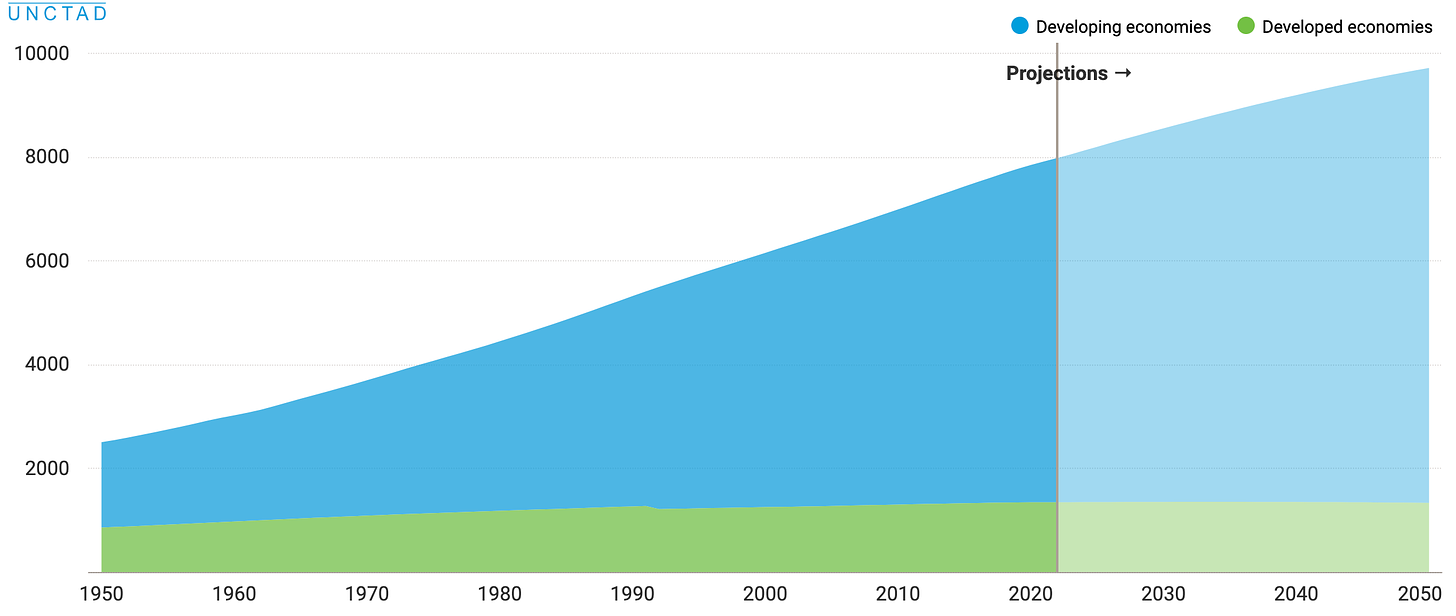Welcome to the mid-week update from New World Same Humans, a newsletter on trends, technology, and society by David Mattin.
If you’re reading this and haven’t yet subscribed, join 24,000+ curious souls on a journey to build a better future 🚀🔮
To Begin
I put the newsletter on pause last week due to travel commitments. To make up for it, here’s a bumper instalment.
This week, new research suggests widespread fears about social media and democracy are well founded; it really does fuel polarisation.
Meanwhile, the UK’s Met Office outlines a future in which we burst through the 1.5C global warming target, but claw average temperatures back underneath it by 2100. And the global population surpasses 8 billion.
Let’s get into it.
📣 Vox populi
How is social media reshaping our democracies? This week saw publication of what is surely the most comprehensive review to date of the evidence.
Published in the journal Nature Human Behaviour, a new paper saw the analysis of hundreds of high quality studies on the impacts of social media on participation, trust, hate, polarisation, and a range of other dynamics inside democratic societies.
The results? They’re mixed, but overall it doesn’t look good.
On the positive front, the researchers found that social media was weakly associated with exposure to more diverse political news — in contrast to once fashionable thinking about social media filter bubbles.
But social media was also associated with decreased trust in democratic processes, increased hate, polarisation, and a tendency towards populism.
An association, of course, isn’t the same as a causal link. But by using analytical methods known as causal inference techniques, the researchers were able to establish that their data does support the existence of a causal link between social media and the phenomena in question.
In other words, that vague feeling many of us have that a connected world is doing strange and troublesome things to our societies? It looks as though we’re right.
⚡ NWSH Take: At the heart of these issues is a powerful truth. Our democracies were designed in the 19th-century; they simply weren’t made to operate alongside ultra-connected, many-to-many media environments. It wasn’t so long ago that we were talking about the impacts of television; then along came Twitter and a whole new wave of disruption. // These days, vague the internet is bad for democracy memes are everywhere; we desperately need evidence, and this report is the most comprehensive attempt yet at providing that. And look at the landscape into which it arrives. Twitter has fallen into the hands of mercurial (some say unstable) billionaire, and the Saudis are now a major investor. There’s rising concern — including that expressed by the FBI this week — that TikTok is a tool of Chinese surveillance and destabilisation. // We urgently need a deeper understanding of the dynamics in play. And next? We need to act. The next wave of research must be on interventions that ameliorate what is damaging and promote what is positive about social. I write often in NWSH on how simulations of complex social dynamics — including entire societies — will allow for new forms of insight across the coming decade. Who will be first to build a meaningful simulation of social media inside a democracy? That kind of simulation will allow us to test various interventions, and find the ones that work.
🚨 Event siren
We’re coming to the end of the year(!) and that means it’s time for end of year trends.
I’m in the lab now, working on the key trends to put on the radar of readers, clients, and colleagues in 2023. And I’m teaming up with my friends at the brilliant Wavelength to share a sneak peak later this month.
We’re hosting a free LinkedIn Live session on Tuesday 29 November at 3pm UK. And a great crowd of insight professionals, marketers, product designers, founders and more is already assembling. Just hit the button below to learn more and sign up:
I’ll be talking about the generative AI revolution we’re living through, why rising numbers of organisations are open sourcing valuable IP, and much more.
Hope to see you there.
🌤 Overshoot calculus
This week, the UK’s prestigious Met Office offered a new perspective on global heating.
The organisation published new research that shows we’re unlikely to keep heating beneath the internationally agreed 1.5C limit. But, say Met Office scientists, it is possible to overshoot 1.5C and then bring warming back down beneath it some time after 2100.
Dr Camilla Mathison, one of the authors of the paper, said:
‘If we overshoot 1.5C, it doesn’t have to be permanent. With deep and rapid reductions post 2030, and development of diverse technologies for the removal of atmospheric carbon dioxide, it remains feasible to meet 1.5C by the end of the century.’
A more full explanation of their argument is made here:
At the heart of their forecast? The Met Office say that dragging warming back below 1.5C will mean developing technologies that suck carbon out of the atmosphere.
⚡ NWSH Take: This research touches on two NWSH obsessions. I’ve written often on how the 1.5C target has drifted out of reach, and the need to channel more resources towards adaptation to a heated planet. And previous instalments have explored bioengineering projects intended to help reduce global temperatures, including the Bill Gates-backed scheme to shoot reflective chalk dust into the atmosphere. // Not so long ago, bioengineering was considered a fringe consideration. The very fact of the Met Office speculating on this eventuality — exceed 1.5C and then deploy climate tech to bring us back down — is a powerful signal of bioengineering’s entry into the mainstream. Meanwhile, the tech is advancing; last week brought news of an Alphabet X research project on the use of machine vision to promote the growth of sea plants that soak up carbon. // So here, via the Met Office, is a new perspective on 1.5C; the dream can still live, even if we exceed the target. But these ideas leave powerful questions unanswered. Can we really develop technologies that will change the climate at scale? How can we be sure they won’t have catastrophic unintended consequences? And if we surpass 1.5C even just for a few decades, what permanent damage will that do? NWSH will keep watching.
🧒 Welcome child 8 billion
This week, a demographic milestone. The UN estimates that the global population surpassed 8 billion on 15 November. It reminded me of an idea I’ve long fermented about technology, modernity, and a long view of the human story.
The population graph across the last 70 years or so looks like this.
But the incredible nature of this demographic story isn’t fully apparent until you put that graph in context. Here’s population growth across the last 12,000 years.
Essentially, not much happened for 11,500 years. Then we exploded. If you’re 47 or older, you’ve seen global population double or more in your lifetime.
Futurists speak sometimes of a coming, technology-fuelled singularity. This hockey stick population chart fuels my belief that such a singularity is best understood as having already arrived.
In physics, a singularity is a point in space-time at which all the usual rules that govern the physical world break down. When we speak of a historical singularity, then, we’re talking about an event or process so transformative that it explodes the rules of the human condition; a definitive break-point in our story as a species.
My contention is that modernity — and the industrial revolution that fuelled it — is just that event. Modernity brought with it changes so transformative that the old world seems, now, unrecognisable. GDP per capita had been stable, and tiny, for a thousand years before 1800; then it exploded. Around 12% of people were literate in 1820; today only 14% are illiterate. Worldwide, over 40% of children born in 1840 died before the age of 5, and it had been that way for thousands of years. Today that stands at 3.9%; we shouldn’t rest, of course, until it falls to zero.
Take the long view, and a certain perspective becomes unavoidable: we’re in the middle of the historical event that changes everything, and it is modernity.
Now, the UN forecasts that global population will peak at 10.4 billion around 2080 and then start to decline. Across the coming decades we’ll face a new set of questions.
First, what does a falling population mean inside modernity? Look at the first graph and it’s clear this is a question developed countries need to contend with now. Second, in a world of 10 billion what is the relationship between human labour and technologies of automation that reduce the need for much labour as we know it?
That’s a question for another time — and the return of the Sunday notes that I’ve long been promising.
🗓️ Also this week
🤖 Amazon showcased its new Sparrow robotic arm, which can identify and pick up specific items for packing. Currently, Amazon relies on humans to know the difference between a DVD, a book, and a pair of socks, and to put each item in the right basket at its fulfilment centres. Sparrow could change all that; Amazon engineers say it can correctly identify over 65% of the millions of products the company handles.
😎 Italy outlawed the use of facial recognition and smart glasses in public spaces. The new law will see local authorities given leeway to make an exception if the technologies are being used to help fight crime.
🚗 The CEO of Ford says it takes 40% less human labour to build EVs than traditional cars. Jim Farley was speaking at a conference in Detroit; he said Ford plans to bring manufacture of components back in-house in order to preserve jobs as the company shifts to EVs.
🇩🇪 Germany blocked the Chinese takeover of the Elmos chip plant in Dortmund. Economy Minister Robert Habeck cited security concerns, saying ‘critical production areas require special protection’.
💨 New research suggests oil and gas producers are massively under-reporting their carbon emissions. The emissions-tracking NGO Climate TRACE say producers are hiding the level of emissions produced by oil and gas fields, which could be up to three times higher than reported.
🌔 NASA launched its Artemis 1 mission, which will see the uncrewed Orion spacecraft travel 40,000 miles beyond the moon before coming back to Earth. The Artemis mission forms the first major part of NASA’s quest to put astronauts back on the Moon by 2025.
👨💻 OpenAI and its partners are being sued because their automated coding tool reproduces open source code without crediting the authors. GitHub Copilot uses a large language model to turn natural language text prompts into code. But several coders say it outputs large chunks of their code without attribution; they’re now joining forces to sue OpenAI, GitHub, and Microsoft. Back in New Week #104 I looked at the question of ownership and attribution when it comes to artists whose work is used to train text-to-image tools.
🌍 Humans of Earth
Key metrics to help you keep track of Project Human.
🙋 Global population: 8,000,643,628
🌊 Earths currently needed: 1.7927720846
💉 Global population vaccinated: 62.8%
🗓️ 2022 progress bar: 88% complete
📖 On this day: On 18 November 1928 the first animated cartoon with sound, Steamboat Willie, is released by Walt Disney.
Speak No Evil
Thanks for reading this week.
The ongoing collision between a 21st-century connected world and liberal democracies made in the 19th-century is yet another case of new world, same humans.
This newsletter will keep watching. And there’s one thing you can do to help: share!
Now you’ve reached the end of this week’s instalment, why not forward the email to someone who’d also enjoy it? Or share it across one of your social networks, with a note on why you found it valuable. Remember: the larger and more diverse the NWSH community becomes, the better for all of us.
I’ll be back next week. Until then, be well,
David.
P.S Huge thanks to Nikki Ritmeijer for the illustration at the top of this email. And to Monique van Dusseldorp for additional research and analysis.



















New Week #106